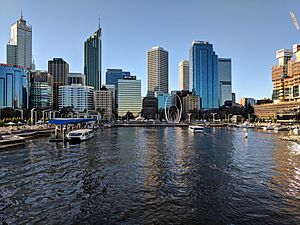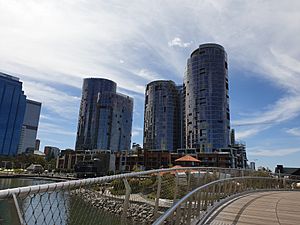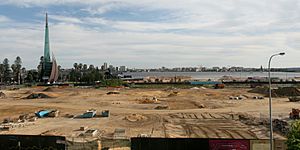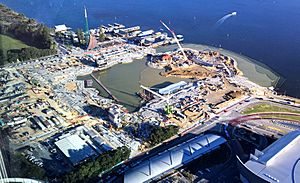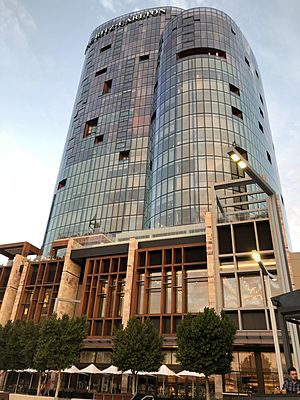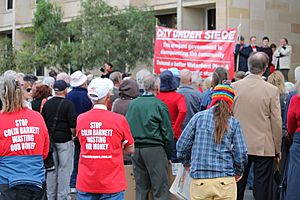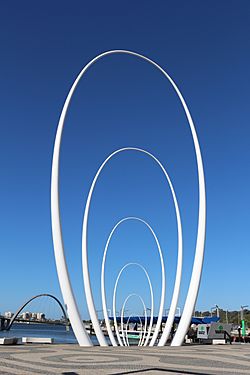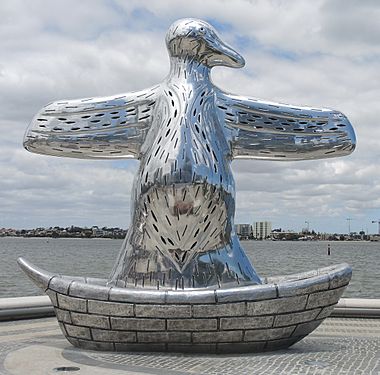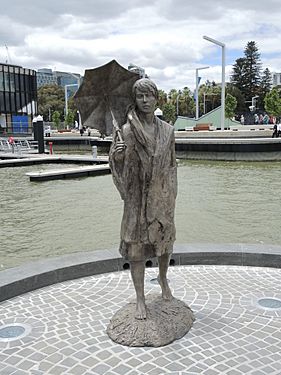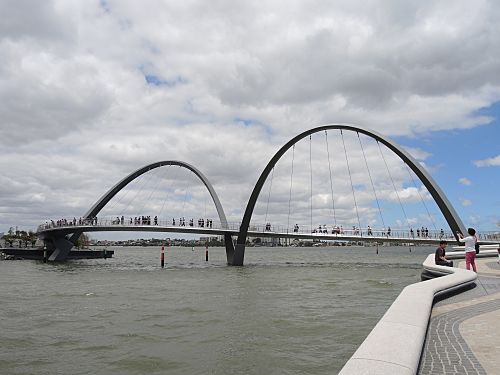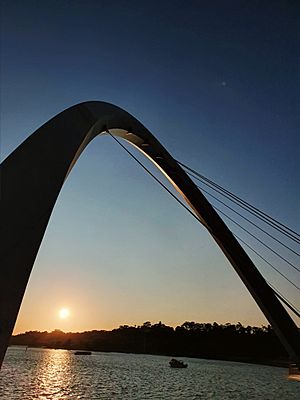Elizabeth Quay facts for kids
Elizabeth Quay is a special area in the city of Perth, Australia. It's a place where different things come together, like homes, offices, and shops. It's built on the northern side of Perth Water, which is part of the Swan River. The quay is named after Queen Elizabeth II to celebrate her Diamond Jubilee.
This project created a new artificial inlet, which is like a small bay, where the Esplanade Reserve used to be. It also changed the areas around it, including Barrack Square. The plan for Elizabeth Quay included nine spots for new buildings. Once everything is finished, there will be about 1,700 apartments for people to live in. There will also be a lot of space for offices and shops.
The building of Elizabeth Quay started on 26 April 2012. The name "Elizabeth Quay" was announced on 28 May 2012. The main part of the quay, including the new water inlet, was finished in January 2016. This was just in time for big events like the Perth International Arts Festival. The quay officially opened to the public on 29 January 2016. Some of the first buildings, like The Ritz Carlton Hotel, opened in November 2019.
Contents
Building Elizabeth Quay
In February 2011, the leader of Western Australia, Colin Barnett, and the Mayor of Perth, Lisa Scaffidi, confirmed the plans for this big project. The government helped pay for it. The total cost from the government was about $440 million. They planned to get some of this money back by selling land to companies that would build on it.
Building Elizabeth Quay meant big changes for nearby areas. Roads like Riverside Drive were moved. Places like Barrack Square also changed. Even old buildings like Lawson Apartments were affected by the construction work.
A special memorial for JJ Talbot Hobbs, which was used for Anzac Day ceremonies, was moved. An old building called The Esplanade Kiosk, built in 1927, was carefully taken apart. Then, it was rebuilt brick by brick on an island in the new inlet.
Some trees in the area were kept, but many were replaced. For example, large Moreton Bay Fig trees were replaced with London plane trees.
The government believed that selling the land would bring in a lot of money. They thought the whole project would be a huge investment. A group called the Metropolitan Redevelopment Authority (MRA) promoted the project. Their slogan was "The river. The city. Together again." They also put up signs around the construction site. These signs shared stories about the old Esplanade area.
In April 2012, the MRA released new plans for the design. They asked for public feedback on these plans.

Concerns About the Project
When the plans for Elizabeth Quay were announced, some people had concerns. They worried about how the project would affect old buildings and the environment.
A meeting was held in 2011 to discuss the history of the site. People wondered if enough care was being taken to protect historical items. They suggested that the area should be carefully checked for old items before digging. During the digging, some old timber poles and steps were found. These were likely from piers built in the 1800s.
There were also worries about how traffic would be affected. Riverside Drive, a main road, had to be moved around the new inlet. To help with traffic, extra lanes were added to the Graham Farmer Freeway tunnel. This was to encourage drivers to go around the city center.
A group called "City Gatekeepers" was formed to oppose the plans. They said the plans were not good and were being rushed without enough public discussion. Many people joined a protest rally on the Esplanade in February 2012. Several petitions against the project were given to the government. The City Gatekeepers also suggested other designs for the area. These designs often kept more of the original Esplanade.
However, supporters of the project pointed out that the land was actually created in the 1930s. This made some people question how much historical value it truly had as just a grassy area and a road.
Water Quality Concerns
Water Park Quality
The water park at Elizabeth Quay had to close in February 2016. This was because of a type of bacteria found in the water. The park had been opened quickly, and some people said there wasn't enough testing done before it opened. It reopened about 10 months later.
Inlet Water Quality
A swimming event planned for the inlet was canceled in March 2016. This was due to high levels of bacteria in the water. During the planning stages in 2012, water experts had warned about poor water flow in that part of the river. They said it was the "worst flushing part" of the whole river system. Some long-time boat operators also shared similar concerns. The inlet is now tested monthly by a private company, unlike the main river which is tested weekly by the government.
Who Built It?
ARM Architecture were the main architects for the project. An urban planner named Richard Weller was also a key consultant.
Leighton Contractors and CIMIC Group were given the main construction contract in December 2012. They built the new inlet, roads, parks, and an island with a bridge. This work covered an area of about 10 hectares. The contract for this part was worth $210 million.
Getting Around
The Esplanade Busport and Esplanade railway station were renamed. They became the Elizabeth Quay Bus Station and Elizabeth Quay railway station when the quay opened in January 2016.
Transperth runs ferries from Elizabeth Quay Jetty to Mends Street Jetty in South Perth. There is also an electric ferry service that goes from Elizabeth Quay to Claisebrook Cove and back.
Plans also allow for a cable car to Kings Park in the future. However, this was not part of the first stage of the project.
Art at the Quay
There are several pieces of public art at Elizabeth Quay:
- Spanda: A tall, abstract sculpture that is about 29 meters high.
- First Contact: A sculpture about 5 meters tall that shows a bird in a boat.
- A statue of Bessie Rischbieth: A statue honoring a famous person.


